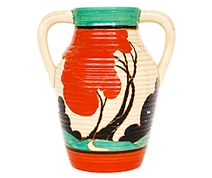The Works of Clarice Cliff
Below is a selection of back stamps commonly found on Clarice Cliff's pottery from 1927 to 1964.
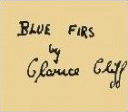
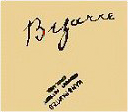
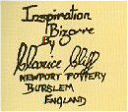
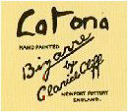
Early back stamps, often hand-written, from the late 1920s / early 1930s (above).

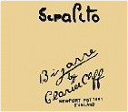

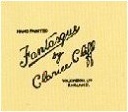
Early 1930s back stamps (above).



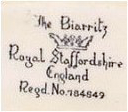
The most commonly seen back stamps used during the early-mid 1930s (above).
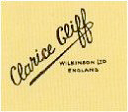
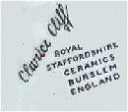
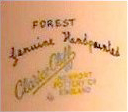
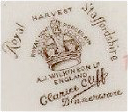
Back stamps used from mid 1930s onwards (two on the left) and back stamps used late - 1940s, 1950s, 1960s (two on the right)
Firstly, note that stamped marks were made with a rubber stamp, speedily applied to ware, so the letters are often irregular with parts missing or 'blobby'. Printed marks (also referred to as lithograph marks) are much finer and regular. They were produced on tissue paper which was stuck on the ware, so they could not be smudged, but sometimes, as they were cut from a sheet, an edge is cut through. Throughout the period 1928 to 1936, both stamped and printed Bizarre marks were applied on-glaze.
Between 1922 and 1927 the Newport Pottery and Wilkinson marks were classical in style with a rampant lion and crown, above a ribbon with 'Royal Staffordshire Pottery' or 'Newport Pottery'. When Bizarre ware revolutionised Newport Pottery the 'Lion' mark soon disappeared but it continued to be used at Wilkinson's for several years. After the hand-painted Bizarre mark in rust colour, the first stamped mark was the classic Hand Painted Bizarre by Clarice Cliff Newport Pottery, which wasstamped in black, in two sizes: it was used from late 1927 or early 1928.
In October 1928 the first Fantasque script mark appeared although briefly this was produced in gilt, crediting 'Newport Pottery'. Script marks were also used for Delecia and Moderne. Stamped marks continued to be used in 1929 and 1930, but the style of the Fantasque one evolved with Fantasque then in block letters, above a Bizarre logo, when Colley made Bizarre the umbrella title for all Clarice's ranges.
More elaborate backstamps were issued crediting tile range name in block letters above a standard Bizarre mark, and these included Crocus and Gayday. However, at the same time many ranges or designs such as Latona, Appliqué and Inspiration, just had the name painted above a standard Bizarre mark. Then, from 1931 as the ranges were formalised, a finer printed backstamp appeared. Variations included Fantasque, Crocus, Latona, Gayday, Cafe'-au-lait, and Nuage. These credited Newport Pottery and had a Bizarre mark with the range name above in block letters. Simultaneously, a stamped Bizarre mark continued to be used which credited Wilkinson's. Elaborate printed backstamps were also used for the Artist in Industrypieces in 1933 and 1934.
The next change was from 1934, when, as the range of designs was rationalised, the printed backstamps became redundant, and a simplified range of stamped or printed backstamps was used until the Bizarre name itself was phased out from February 1936 onwards.
Under-glaze marks on Clarice's ware are various, and looking just at 1927 to 1936 the following will be found:
Early Bizarre designs on old shapes may have a Newport Pottery England mark or a green Wilkinson's England. From 1929 a Registration Applied For mark was applied to many of Clarice's new shapes as she was forced to register these to deter copies. As it referred to the shape this was stamped under-glaze. A Honeyglaze backstamp was also used extensively from 1929. This was a full mark designed to resemble the Bizarre backstamp: Wilkinson England Honeyglaze Hand Painted. As it referred to the glaze on the body, it was again applied under-glaze. If the piece was then decorated in a Clarice Cliff design, a printed Bizarre mark was added on-glaze.These marks were applied in a haphazard manner, so occasionally a Clarice Cliff design lacks her mark, which adds to the intrigue!
The most common underglaze mark is the Biarritz one: The Biarritz Royal Staffordshire Great Britain Regd. No.784849. This was used from 1933 onwards. The Biarritz shape range was instantly registered to stop copyists ~ it clearly worked as none of Clarice's competitors produced oblong and square plates! This mark remained as the sole backstamp if the ware was decorated in Wilkinson's designs, or a further backstamp was added if it was in a Clarice Cliff design: in the example shown there is just part of the on-glaze printed Bizarre mark. The Biarritz backstamp is also sometimes found on Bon Jour shapes which were the tea, coffee and fancies part of the range.
Confusing Marks: although the factory tried to mark every piece, ware with a small base area was sometimes given no mark, or just part of a mark. For example, Muffineer sets which already had a Newport Pottery England mark under-glaze might have just Bizarre or Clarice Cliff. However, the actual design on the piece tells us they are from between 1928 and 1936. Yet, collectors finding a small piece which lacks a full mark are sometimes deterred from buying.
There are many variations to the back stamps pictured here and some pieces can carry more than one type of back stamp. Also, during the 1930s some pieces did not get any stamp at all!





